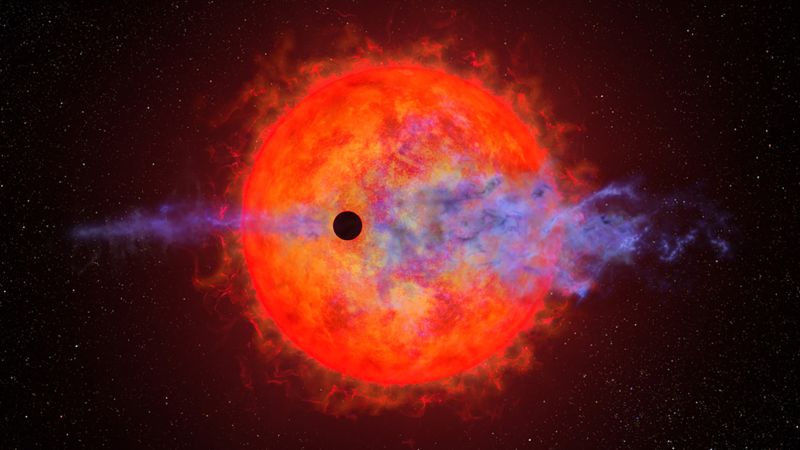Hubble Telescope Captures Dramatic Change in Nearby Planet’s Atmosphere
The Hubble Space Telescope has made an unexpected observation of a nearby planet that is experiencing its atmosphere being blasted away by its star. This is a significant change from the last time Hubble checked on the planetary system and found nothing wrong.
A Young Planetary System
The red dwarf star, known as AU Microscopii or AU Mic, is located just 32 light-years from Earth, making it relatively close in astronomical terms. It is home to one of the youngest planetary systems ever observed, with the star being less than 100 million years old, much younger than our own sun.
Discovery and Surprising Observations
The system was initially discovered by NASA’s retired Spitzer Space Telescope and the Transiting Exoplanet Survey Satellite during observations in 2020. The presence of a gaseous world orbiting in front of the star was revealed by a slight dip in its brightness.
When the Hubble Space Telescope observed one orbit of the exoplanet, everything seemed normal. However, when it revisited the system a year and a half later, astronomers were shocked to see that the closest planet to the star, AU Mic b, was being heavily impacted by the star’s radiation. The planet’s hydrogen atmosphere was evaporating due to the intense radiation. There may be more undiscovered exoplanets in the system.
Unusual and Challenging Observations
The findings of this study, which will be published in The Astronomical Journal, have left scientists puzzled. The rapid change in the planet’s atmosphere is not something that has been observed before. The observations challenge existing models and theories about planetary evolution.
The Role of Red Dwarf Stars
Red dwarf stars like AU Mic are the most common type of stars in the Milky Way and are often found to host planets. These stars are smaller and cooler than our sun but are known to release strong stellar flares for extended periods of time.
The Impact of Radiation
AU Mic b, located just 6 million miles from the star, is bombarded by flares, X-rays, and stellar wind. The planet’s atmosphere heats up to the point where it escapes the planet’s gravity and dissipates into space. This extreme interplay between the star and the planet is a unique opportunity for scientists to study the effects of stellar radiation on planetary atmospheres.
Searching for Habitable Planets
Astronomers are now trying to determine whether planets closely orbiting red dwarf stars can retain their atmospheres in the face of such radiation. They are also investigating the potential habitability of these planets. The ultimate goal is to understand what these planets might look like once the star settles down and whether they could support life.
Unanswered Questions
There are still many unanswered questions about the planet’s atmospheric loss and the variability of the star. Astronomers will continue to conduct follow-up observations with the Hubble Telescope to track the changes in the planet’s atmosphere over time.
Intriguing Discoveries in the Universe
This unexpected observation by the Hubble Space Telescope provides valuable insights into the complex relationship between stars and planets. It challenges our understanding of planetary evolution and raises intriguing questions about the habitability of planets orbiting red dwarf stars. Further research and observations will help unravel the mysteries of the universe and expand our knowledge of distant planetary systems.
Hubble Captures Stunning Images of a Star Obliterating a Planet’s Atmosphere
In a remarkable display of its unrivaled capabilities, the Hubble Space Telescope has recently captured breathtaking images of a star obliterating a planet’s atmosphere. This extraordinary event, observed in a distant planetary system, provides scientists with invaluable insights into the destructive forces at play in the universe.
The Hubble Space Telescope, a joint project between NASA and the European Space Agency (ESA), has been instrumental in revolutionizing our understanding of the cosmos since its launch in 1990. Equipped with cutting-edge technology and positioned outside Earth’s atmosphere, Hubble has consistently delivered awe-inspiring images and groundbreaking scientific discoveries.
The latest revelation from Hubble involves a star located in a planetary system approximately 150 light-years away from Earth. This star, known as WD 1145+017, is a white dwarf—a remnant of a star that has exhausted its nuclear fuel and shed its outer layers. What makes this discovery particularly captivating is the star’s interaction with a nearby planet.
Using its powerful instruments, Hubble observed the white dwarf as it passed in front of its host star, causing a temporary dimming of the star’s light. However, what astonished scientists was the presence of multiple rings of gas surrounding the white dwarf. These rings are believed to be remnants of a planet’s atmosphere that has been torn apart by the star’s immense gravitational forces.
The images captured by Hubble reveal a mesmerizing sight—a series of concentric rings encircling the white dwarf. These rings are composed of various elements, including hydrogen, helium, and heavier elements like oxygen and sulfur. The presence of these elements provides crucial evidence of the planet’s atmosphere being stripped away and dispersed into space.
The destruction of a planet’s atmosphere by a star is a rare event to witness, and Hubble’s ability to capture such a phenomenon is a testament to its unrivaled observational capabilities. Scientists believe that this occurrence is a result of the white dwarf’s intense gravitational pull, which causes the planet to be stretched and eventually disintegrated.
The insights gained from this observation have significant implications for our understanding of planetary systems and the evolution of stars. By studying the process of atmospheric destruction, scientists can gain insights into the fate of other planets in similar systems and the potential habitability of exoplanets.
Furthermore, this discovery sheds light on the ultimate fate of our own solar system. In billions of years, our Sun will exhaust its nuclear fuel and transform into a white dwarf, potentially leading to the destruction of any remaining planets in our system. Understanding the mechanisms behind such events is crucial for comprehending the broader cosmic processes that shape the universe.
The Hubble Space Telescope’s ability to capture these stunning images not only inspires awe and wonder but also advances our knowledge of the universe. Its continued exploration of distant planetary systems and celestial phenomena promises to unravel the mysteries of the cosmos and provide us with a deeper understanding of our place in the universe.
As we marvel at the beauty and power of the universe, we are reminded of the invaluable role played by scientific endeavors like the Hubble Space Telescope. With each new discovery, we inch closer to unraveling the secrets of the cosmos and expanding the boundaries of human knowledge.









